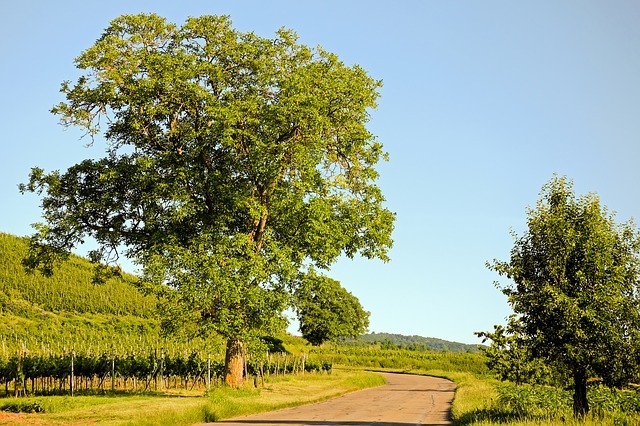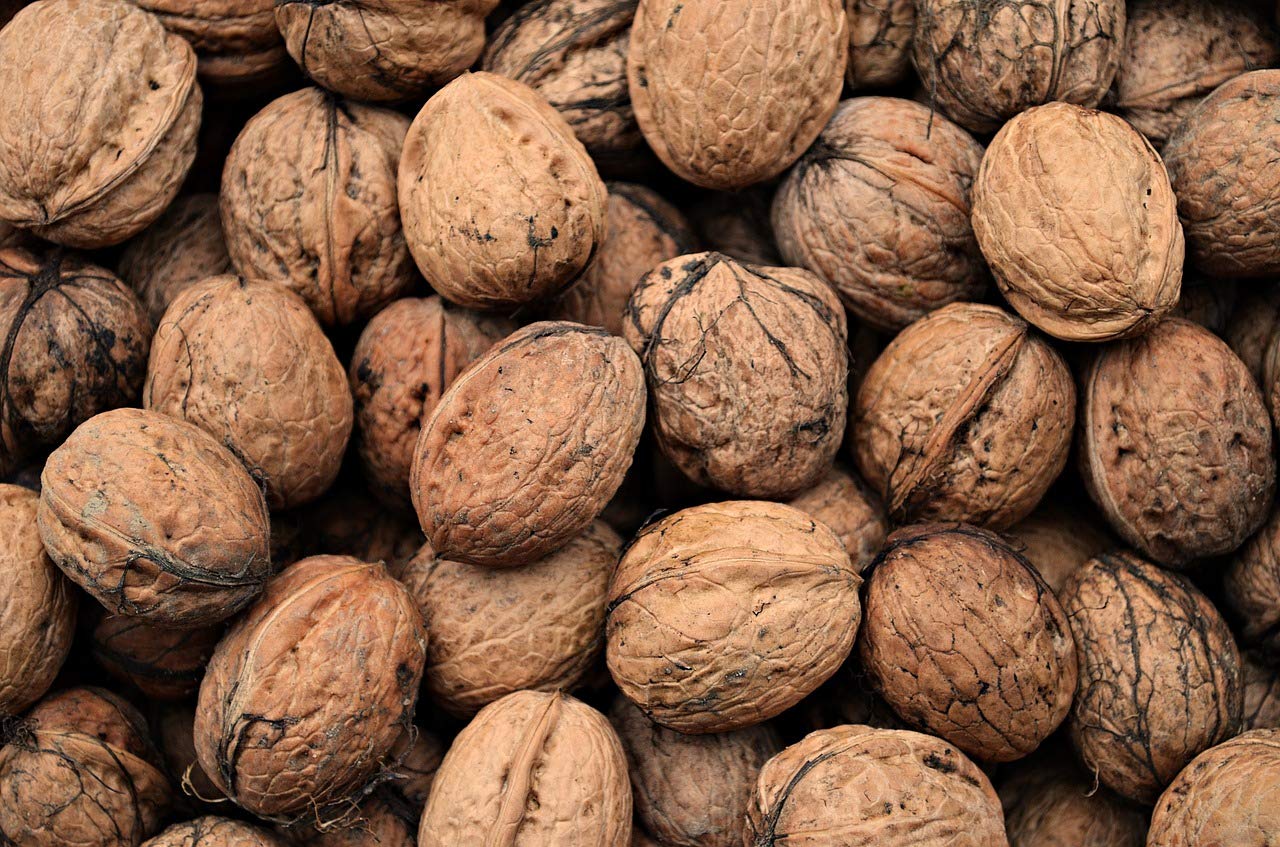If you love to eat walnuts and have considered growing a tree on your property, this article is for you. We’ll not only show you how to grow a walnut tree, but we will also identify the best climate conditions for this process and answer the burning questions you may have regarding walnut trees and walnuts in general. Stick with us to the end and you’ll know everything you’ve ever wanted or needed to know about walnuts and growing a walnut tree, including the health benefits of eating walnuts and how to enjoy their flat-out good taste. Let’s take a look.
What Are Walnut Trees?
Walnut trees, more formally (and scientifically) known as Juglans Reglia, are fast-growing, nut-producing trees. There is a wide range of trees within the Juglans species. The seed of this tree develops into what we call walnuts, including English walnuts, California walnuts, and African walnuts. People enjoy more than 30 varieties of walnuts.

Image from Pixabay
Walnut History
Walnuts are the oldest food to come from a tree. In fact, the earliest trade of the walnut dates back to the ancient Persians. Historically, the walnut has been an important food for human diet, and it is useful as well for its medicinal benefits, knowledge of which goes back to the earliest Mediterranean civilizations. People from Mediterranean cultures believed walnuts helped reduce breast inflammation and inflammation resulting from dislocations. Eventually, walnuts gained economic value and became a rich part of Asian trade, gradually making their way through Europe. By the 1700s, walnuts had reached California, where they are now commercially planted and harvested.
What Do You Need to Grow a Walnut Tree?

Image from Pixabay
Best Climate
Walnuts grow best in Mediterranean-like climate zones. That is one reason California has enjoyed so much agricultural success with this product. Just like any other fruit or nut, walnuts thrive in sunny areas.
The variety of walnut you desire will dictate the best temperature for growth. Many areas of California are conducive for walnut trees to prosper. The Midwest states, such as Iowa, Indiana, and Missouri, also contain successful walnut orchards. For the most part, extreme high and low temperatures are problematic for walnut growth.
Temperature to Break Dormancy
Specific temperature requirements are required to break the dormancy of a bud. It is critical that the walnut be exposed to temperatures less than 45°F or 7°C for about between 700 and 1,000 hours.
Optimal Soil Conditions
Soil for planting walnut trees should be well-drained. However, even if you have sun and well-drained soil, it will take you approximately 5 to 7 years to reap the rewards of your walnut tree.
Optimal Locations
Depending on where you live, there are some key considerations for the variety and viability of walnut tree growth. Areas that tend to work well are found along waterways, such as rivers and seas. If you live near a hillside or mountainous area, you may not achieve the same level of success as your riverside friends.
Pollination
A unique aspect of the walnut plant is that it is monoecious. In layman’s terms, this means the tree bears both male and female flowering parts. When pollen blown from the flowering male part settles on the receptive point of the flowering female part, fertilization occurs. When this happens successfully, the female flowering part will turn into what becomes the nut.Being monecious, the walnut tree is self-sufficient, which makes it an easier crop to grow.
Can You Grow a Walnut Tree from a Walnut?
You can indeed grow a walnut tree from a walnut. The process is far easier than you might expect. If you’re lucky enough to come across a walnut tree, start by locating and gather a bunch of fallen walnuts.
On the other hand, hybrid plants are made up of two or more cultivars. A cultivar is a name for a plant which is selected for growing. A hybrid plant is developed by growers to have desirable traits from its parent plants.
Test Your Walnuts
After you remove the husks from the collected walnuts, you’ll want to place the nuts into a bucket of water. What you’re looking for is the walnuts that sink versus the ones that float. Discard any walnut that floats as it is not viable for growing a walnut tree.
Stratification
This term refers to duplicating the natural processes that affect a seed in order to prepare it for germinating. In the case of a walnut, stratification involves achieving a proper temperature and a proper moisture level.
Temperature Exposure
As we’ve already discussed, a walnut requires cold temperatures to support the proper transition from dormancy to buds. Gather your walnut buds in an old coffee can and store it in your refrigerator at a temperature just above freezing. Leave it there for between 90 and 120 days.
Moisture Requirement
It is essential not only to achieve cold temperatures, but also to attain proper moisture. Areas with an annual rainfall below 23 inches or 600 mm may not be adequate for walnut development. Too much sun can also be detrimental to your walnut trees by causing sunburn. Just as sunlight affects our skin, it can make your walnut shrivel and darken, rendering it useless as a seed.
Facts About Walnuts

Image from Amazon
Although people all around the world today enjoy walnuts and use various aspects of the walnut tree, there was a time when walnut eating was a delicacy reserved for royalty. In fact, the name Juglans Reglia, which was given by the Romans, means “Jupiter’s Royal Acorn.” Here are a few more facts about walnuts and walnut trees.
Health Benefits
A great deal of research is focused on uncovering scientific evidence about how walnuts support our health. These tasty nuts are known to offer a range of health benefits. The bottom line is that walnuts are chock full of vitamins, fats, minerals, and fiber. Eating a handful of walnuts is proven to be both delicious and nutritious.
- Walnuts have the highest antioxidant properties as compared to all other nuts.
- They have anti-inflammatory properties benefiting people suffering from conditions such as cancer, Diabetes, Alzheimer’s, and heart disease.
- They are good for appetite control as they are calorie dense.
- Walnuts’ polyunsaturated fat, Vitamin E, and polyphenols mean they have a positive effect on brain function.
Role in Vegan Diets
Creating nutrient-dense meals that provide proper dietary benefits can be a challenge for vegans. Walnuts are a great component of vegan diets.
- They are made of complex carbohydrates but don’t have high sugar content like many other carbs do.
- Walnuts are high in protein and are thus energy rich.
- Their high fiber content helps with the body’s ability to process and eliminate foods.
- Walnuts are a great source of good fats.
How to Eat Walnuts
You don’t need to get fancy to enjoy a walnut. You can simply shell the nuts and eat them raw or you can bake them. We’ve included a few creative ways to serve them.
- Chop them and add them to your favorite food, such as cereal, yogurt, or oatmeal.
- Use them as a topping. If you have a sweet tooth, add walnuts to goodies such as ice cream and brownies.
- Add them to your salad. They are especially tasty when combined with apples.
Benefits of Growing Walnut Trees
There are many common uses for walnut trees, all of which are profitable for the grower. You can sell everything from the tree to the walnut and its sap.
- Walnuts can be eaten in any form, whether raw or prepared.
- Walnut tree sap is also edible and can be consumed like maple sap.
- You can use walnut oil for cooking.
- You can use the leaves from the tree to make wine.
- Wood from the walnut tree is some of the most durable for building and flooring.
Potential Problems for Walnut Tree Growth

Image from Amazon
As is the case for growing any agricultural product, growing walnut trees presents some concerns. For walnut trees, insects are usually the biggest problem, and they can kill your product. Another potential problem is the development of diseases on your trees. These diseases can attack and rot a walnut tree from the root up, via the bark, or via bud formation.As already discussed, extremes of temperature are another threat to your harvest. Extreme heat can lead to sunburn, and extreme cold can lead to frostbite. Both spell trouble for your walnut trees. Don’t forget to choose well-drained soil for your grove, but be sure to maintain the right level of moisture for your trees. Planting on hillsides or in mountainous areas might create too many challenges for walnut trees. Look for well-drained soils along rivers.
Conclusion
Walnut trees are truly a wonder species. Not only is the budding nut full of nutritional benefits, but the wood of the tree itself can also be harvested for profit. However, the successful growth of a walnut tree requires an adequate environment. Finding the proper balance between temperatures that are not too cold yet cold enough to allow budding and not too hot can be a challenge. Maintaining the proper soil moisture is also critical. In the right areas, this superfood can sustain life. But, remember, you’ve got to get started early, as walnut trees take at least five years to start producing nuts.
Last update on 2024-04-25 at 03:35 / Affiliate links / Images from Amazon Product Advertising API
